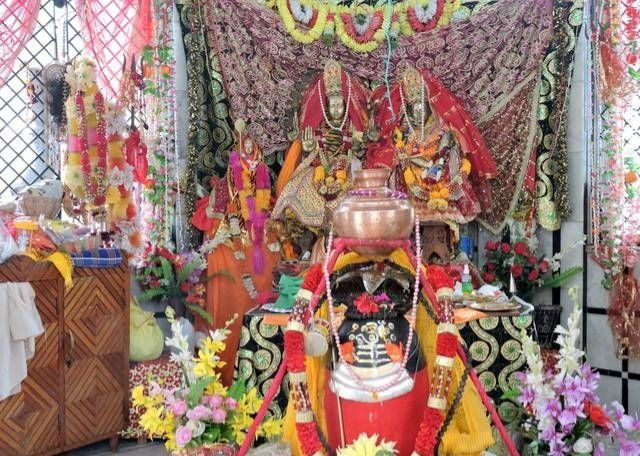Manikaran: Place of Holy water
- Sheena

- Apr 5, 2020
- 4 min read
The city of Manikaran is located in the parvathi valley at northeast of Bhuntar in the Kullu District of Himachal Pradesh. It is situated at an elevation of 1760 m, about 35 km away from Kullu. It is believed that Manu recreated human life here after the flood making it a sacred place and a pilgrimage site for Hindus and Sikhs.

Manikaran is worldwide known for its natural hot springs and stupendous landscapes. According to mythology, when the Hindu God Shiva and his consort Parvati were going through the valley, th Godess Parvati dropped her earring. The trinket was seized by Shesha(the serpent deity) who then escaped into the earth.The lord Shiva performed the Tandava and that is when Shesha surrendered the trinket and shot the jewel up through the water. Seemingly, jewels continued to be thrown up in the hot waters springs at Manikaran until the 1905 Kangra earthquake.

According to the Sikhs, in the period of third Udasi, the sikh founder Guru Nanak came here with his disciple Bhai Mardana. Mardana felt hungry and there was no food so Guru Nanak sent Mardana to collect food for the Community Kitchen(langar). Many people donated atta(flour) to make Roti(bread) but the only problem that persisted there was no fire to cook food. Guru Nanak asked his brother Mardana to lift a stone and then what they saw was a hot spring coming up. As instructed by Guru Nanak, Mardana placed the raw chapatis in the spring to his despair the chapatis sank. Guru Nanak and Mardana then prayed to God saying that if their chapatis float back then he would donate one chapati in His name. When they prayed all the chapatis started floating and were duly baked. Guru Nanak then said that anyone who donates in the name of God, his drowned items float back.
I visited Manikaran on my way back from Manali and it took us around 1.5hrs to reach there. We reached at 7 A.M. in the morning and we had a whole day to cover Manikaran before departing on our bus to Delhi. We made a good use of our time and covered most of the places there. Our list included Manikaran Sahib Gurudwara, Lord Shiva Temple, Lord Ramachandra Temple, Naina Bhagwati Temple.

Manikaran Sahib Gurudwara: Manikaran is well known across the globe as a Sikh pilgrimage site with 1000 plus devotees coming everyday to visit the Manikaran Sahib Gurudwara. The Gurudwara has a grand shrine which give rise to the enchanting sanctity and devotion to the pilgrims who visit it. The Gurudwara is perched on a hill and surrounded by hotels, restaurants and small shops. The Gurudwara is made with shimmering white marbles which radiates the positive energy in its surroundings. The Gurudwara is all covered with saffron flags flowing on top of it which adds color to the site.
The hot yet comforting pools of natural hot spring available in this place are a significant part of this place. The hot spring below the temple makes the inner sanctum and even the floors of the Gurudwara so hot that it becomes unbearable for the tourists. Water in the pool is believed to be very auspicious and sacred that can rinse all the sins one had done in his lifetime. It even cures health problems like muscle pain and arthritis.

Gurudwara also has a free food community(langar) that is open for everyone. The langar served in Gurudwara is cooked with the heat of hot spring water from beneath and doesn't required any use of fire. On the visit to Manikaran one should definitely have langar food and indulge yourself in the magic of mother earth.
Lord Shiva Temple - After Gurudwara sahib we headed towards the ancient Lord Shiva Temple, a shrine dedicated to the Lord of lords, Lord Mahadev. The temple was built in the year 1905 at an height of 2650m above the sea level & in the middle of the Himalayan foothills. On one side of the temple you will find the freezing cold water coming from Parvathi valley and on the other side the boiling hot water spring.

The Lord Shiva Temple is famous for its architecture and the surrounding scenic beauty. When you visit the temple, you will find it unusually tilted on one side. This inclination of the temple is because of the earthquake destruction. It is believed that demi-gods themselves come down from heavens to worship Lord Shiva in form of Shivalinga here. This temple welcomes devotees whole of the year and you can visit it any day. Since monday is said to be a day of lord Shiva and on festivals like Shivratri, you will find temple more crowded than the other weekdays.

Lord Ramachandra Temple - Lord Ramachandra Temple as its name defines is dedicated to lord Ram who is said to bought this temple from Ayodhya, where he was born. Some also believe that this temple was built by Raja Jagat Singh in the 17th Century and he installed here the idol of Lord Ram which he got from Ayodhya. This temple is covered by mountains all around and offers a delightful site to its visitors. The temple comprises of exquisite sculptured idols of the divine couple, Ram and Sita.


Naina Bhagwati Temple - Naina Bhagwati Temple is a well known temple situated on the foothills of the great Himalayas in Parvathi valley. This temple is dedicated to deity Naina Bhagwati that arises from Lord Shiva’s third-eye. This temple is very popular and is visited by devotees on a large scale. The wooden carvings inside the temple makes it more attractive to the tourists. Huge number of devotees visit this temple every year making it one of the top tourist attraction in Himachal Pradesh.






Comments